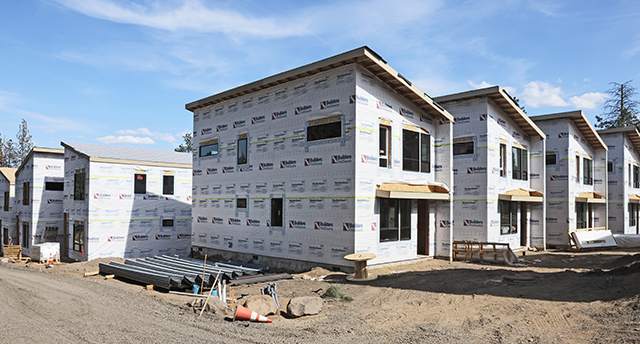Rethinking retirement communities
Published 12:00 am Friday, June 6, 2014

- Kalim A. Bhatti / The New York TimesDonna and Roger Shenk stand on the balcony of the clubhouse at Liberty Hill, an age-restricted community in Boalsburg, Pa. Instead of focusing on traditional Sun Belt retirement communities, builders are seeking to lure older people who want to remain active or continue to work.
When Rikki Selby began shopping for a retirement home, the 66-year-old sought a community where she could make friends with people her own age. But Selby had no interest in the kind of sprawling Sun Belt development that offers thousands of houses to older people.
“In those places, everybody is old, and you don’t see young faces in the supermarket,” said Selby, who recently retired as a financial planner.
To enjoy more diversity, Selby moved to Rancho Mission Viejo, a development near San Juan Capistrano, Calif., that caters to a variety of age groups. She purchased a single-family home in a section reserved for homeowners 55 and older. But a few blocks away are houses designed for families with children. In another nearby area, apartment projects seek to draw single 20-somethings. Everyone can mingle in common recreation areas.
The California project is one of many efforts by developers to think more creatively about housing options for a demanding generation that has begun to reach retirement age. Instead of focusing on traditional Sun Belt retirement communities, builders are seeking to lure older people who want to remain active or continue to work. Pleasing retirement-age customers is crucial for developers. At a time many housing markets remain stagnant, projects catering to older people rank as one of the hottest fields. In 2013, there were 21,000 starts of age-restricted homes, up from 13,000 in 2012, according to the National Association of Home Builders.
Like other home buyers, many older consumers postponed purchases during the financial crisis, said Steven Bomberger, president of Benchmark Builders in Wilmington, Del. But people older than 55 have been among the first to return to the markets, said Bomberger, whose firm sold 42 age-restricted houses in 2013, up from 22 the year before.
“Seniors can move now because they have equity in their longtime homes, and they are ready to sell and get on with their lives,” Bomberger said.
Demand for age-restricted communities will continue growing rapidly during the next decade because of demographics, said Gregg Logan, managing director of RCLCO, a real estate consulting firm in Orlando, Fla. Logan said the number of people ages 60 to 75 would increase to 56 million in 2025 from 46 million now.
People in their late 60s are particularly likely to buy a home in an age-restricted community.
Although many older residents prefer restricted neighborhoods for privacy and quiet, developers have been forced to offer features that are suitable for increasingly active customers who want more variety.
“Today people do not want a geezer ghetto,” said Margaret Wylde, president of ProMatura Group, a market research firm in Oxford, Miss., that specializes in older consumers. “Buyers want an active environment with walking trails and easy access to amenities outside the community.”
Experimental communities
Del Webb, a construction company, has long been a leader in developing new forms of retirement communities. In 1960, the company opened Sun City near Phoenix, which offered an 850-square-foot home for $8,500. The company’s founder, Del E. Webb, sought to build an entire community for retirees that would provide shopping along with shuffleboard. The project was a smashing success. According to the company, 100,000 visitors toured the development on its opening weekend, and the project sold 1,300 homes the first year. Sun City grew to 46,000 residents.
Over the years, Del Webb — which is now a unit of PulteGroup — built a series of Sun Belt retirement communities, constantly adding features, including indoor walking tracks and the latest exercise equipment. But by the late 1990s, the developer began to notice that many customers preferred retiring within driving distance of their hometowns where they could see relatives or enjoy cultural opportunities. As a result, developers began building communities outside the Sun Belt.
Meet the demand
In recent years, Del Webb has built age-restricted projects near Chicago, Detroit, Cleveland and Boston.
“Our residents want to be close to their doctors and family members,” said Valerie Dolenga, a Del Webb spokeswoman. “About 50 percent continue to work at least part time.”
Roger Waller, 57, recently sold his 4,000-square-foot home to move to a nearby 1,670-square-foot condo in Potomac Green, a Del Webb project in Ashburn, Va., about 30 miles from Washington. Condo prices in the development range from about $189,000 to more than $356,000. Waller, a dispatcher for the Arlington County 911 system, plans to stay in his apartment when he retires. He pays about $300 a month to the development’s homeowners association, which takes care of lawn mowing and other maintenance.
“When I owned a house, I did yard work and remodeling,” Waller said. “Now I will be able to retire and not worry about chores.”
Bomberger said that about half the residents in Benchmark’s Delaware communities work. Some commute to Wilmington or Philadelphia. Others left longtime jobs and now work from home as consultants. To serve them, Benchmark installs home offices in many of its projects.
“We see bankers and DuPont engineers who decide to open their own shops,” Bomberger said.
Feel of community
When Donna Shenk, 66, retired from her job teaching elementary school, she wanted to downsize and remain near State College, Pa. She and her husband, Roger, a 68-year-old retired engineering manager, decided to buy a home in Liberty Hill, a local age-restricted community where houses are typically priced from $290,000 to $349,000. The Shenks soon decided that what they liked most about the development was the social life. Residents organize parties and exercise classes at the community’s clubhouse. Groups play tennis and form clubs. The Shenks have taken classes with their neighbors at the nearby campus of Penn State.
“We are a group of empty nesters, and we do lots of things together,” Shenk said.
Outdoor amenities
The multigenerational community of Rancho Mission Viejo in California is designed to offer a range of outdoor activities. Older residents can choose to swim laps at a pool that is limited to ages 55 and older. They can also take grandchildren to a nearby pool that is open to people of all ages. Hiking trails go through the community and run over nearby mountains, and beaches a few miles away draw surfers of all ages. Residents use the Internet to organize activities, inviting neighbors to poker games or camping trips.
Homes are priced from around $500,000 to more than $1 million. The developers hope to attract extended families. Recently a couple bought a house in an age-restricted section, while their daughter moved nearby to a street that is open to people of all ages.
Even when projects cater to active adults, some developers offer features that are designed for an aging population. Many houses have only one floor so residents will not have to climb steps. In two-story houses, the master bedrooms are on the first floor.
Odette Haight, 67, is still working part time as an office administrator, and she can run up stairs. But she opted for a master bedroom on the first floor when she decided to buy a home at the Village of Long Creek near Newark, Delaware.
Her grandchildren can use a loft bedroom on the second floor.
“If I want to spend the rest of my life in the house, then I need to think ahead,” she said.







